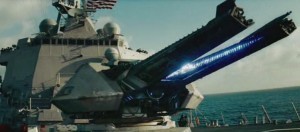Weapons of the Future: The US Navy’s new Railgun
 Science Fiction has often speculated about the weapons of the future. There are phasers, photon torpedoes, laser cannons, pulse rifles, powered suits, battle mechs, warships in space, ion cannons, blasters, and the one we are all hoping for, the light saber. While we are probably decades away from most of these (maybe centuries), one futuristic armament has become a reality: the railgun.
Science Fiction has often speculated about the weapons of the future. There are phasers, photon torpedoes, laser cannons, pulse rifles, powered suits, battle mechs, warships in space, ion cannons, blasters, and the one we are all hoping for, the light saber. While we are probably decades away from most of these (maybe centuries), one futuristic armament has become a reality: the railgun.
The first time I heard of the weapon was in the movie Eraser. Arnold Schwarzenegger fights evil weapons manufacturers trying to sell handheld railguns to terrorists. In the movie, the weapon could fire a lightweight aluminum round almost the speed of light. It’s armor-piercing capability unmatched by any modern rifle or cannon. On TV a railgun or mass driver has made appearances in Babylon 5 as well as Stargate Atlantis. Even before that, science fiction authors like Arthur C. Clarke and Robert Heinlein described weapons similar to the railgun concept.
A railgun uses electricity rather than chemical propellent to launch a projectile. The weapon consists of a barrel with two parallel rails (hence the name), a battery or some other major power source, and a round designed to travel at extremely high velocities. The round accelerates along the two rails. One is a negative rail, one is positive with the round held between the two completing the circuit. Electrons flow from battery or power cell, to negative rail, through the round, to the positive rail. The currents are going in two different directions, which produces a Lorentz force, accelerating the projectile to incredible speeds.
The what gives a gun power is not the size of the round but its velocity. Larger rounds contain more propellent, hence have more velocity. Their size or weight isn’t as relevant. Artillery uses enormous explosive rounds, but generally a line-of-sight weapon relies on velocity, not mass or explosives. A typical rifle can fire a round (nothing more than a small piece of metal) to about 2,500 mph. According to the US Navy, their new railgun can reach muzzle velocities of over 6,000 mph. Researchers have been able to alter the power of the electromagnetic pulse, altering the velocity and trajectory of the projectile, giving it additional battlefield capabilities, such as air defense and even indirect fire. They believe its effective range could be 100 miles! Such a weapon could strike Washington D.C. from Richmond with no trouble.
explosive rounds, but generally a line-of-sight weapon relies on velocity, not mass or explosives. A typical rifle can fire a round (nothing more than a small piece of metal) to about 2,500 mph. According to the US Navy, their new railgun can reach muzzle velocities of over 6,000 mph. Researchers have been able to alter the power of the electromagnetic pulse, altering the velocity and trajectory of the projectile, giving it additional battlefield capabilities, such as air defense and even indirect fire. They believe its effective range could be 100 miles! Such a weapon could strike Washington D.C. from Richmond with no trouble.
Cruise missiles can accomplish this feat today, but they require rocket fuel, a guidance system, and an explosive warhead. In addition, a railgun leaves no chemicals behind after impact, it is purely a kinetic weapon. There would be no unexploded ordnance left behind, which can be dangerous even years after the war is over. As long as the electricity is generated from a clean energy source, the weapon leaves no carbon footprint (doesn’t need fuel).

Railgun from Transformers
The US Navy railgun is large, heavy, and requires a lot of energy. The batteries are charged by a warship’s power plant. It is not ready to be a land-based weapon. The current version is too heavy to move on a vehicle (the gun mount, barrel, and power cell). Maintenance is also an issue. It is unclear how reliable the weapon is, and whether it can withstand battlefield conditions.
The Navy predicts it will begin arming its surface warships with railguns in the next couple years.
Electromagnetic-powered weapons are becoming more practical as we learn more about electromagnetism, as well as alternative means of producing and storing electrical energy. If scientists can develop a means of generating and storing large amounts of electricity, energy weapons will replace the traditional rifle and cannon on the battlefield. In other words we would see the rail cannon, or any other variant of the terms for a non-chemical projectile weapon.
Since an electromagnetic pulse is used to propel the projectile, we could see the terms pulse rifle and pulse cannon used for a projectile weapon. Science fiction has sometimes used to the terms to refer to direct energy weapons, but no one owns the rights on what futuristic weapons will actually be called.
The other technology that could change warfare is of course direct energy, or lasers. Lasers also require a lot of energy, and also have reliability issues. They also generate a lot of heat. Still, the technological challenges are surmountable.
We are a few years from the ship-mounted railgun. We might be a decade or two away from all chemical-propelled artillery and rockets being replaced with railguns as well. It will change the focus of militaries away from chemicals and ammunition, to energy. Electrical energy sources and storage will become the most important supplies for an army.
J
The post Weapons of the Future: The US Navy’s new Railgun appeared first on Jacob Foxx.



